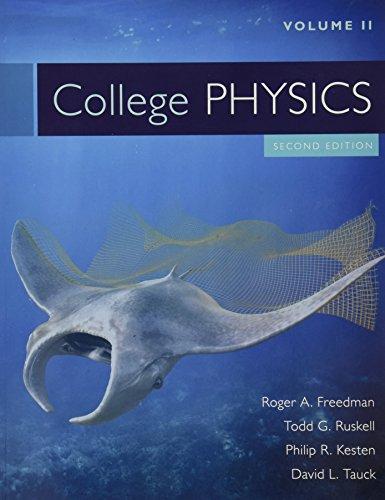
Concept explainers
(a)
Show that the ratio of the frequency of any semitone to the frequency of the note just below it is 21/12
Answer to Problem 104QAP
The ratio semitone to the frequency of the note just below is 21/12
Explanation of Solution
Given:
The 12 semitones of octave are as follow.
Introduction:An octave or perfect octave is the interval between one musical pitch and another with double its frequency.
Further octaves of a note occur at times the frequency of that note (where n is an integer), such as 2, 4, 8, 16, 32, 64 etc. and the reciprocal of that series.
The octave is divide into 12 semitone of equal ratio r.
Calculation:
Conclusion:
The ratio semitone to the frequency of the note just below is
(b)
The frequency of F# in the tempered scale, If
Answer to Problem 104QAP
The frequency of F# is 370 Hz
Explanation of Solution
Formula used:
The ratio of the frequency of any semitone to the frequency of the note just below it is
Calculation:
Conclusion:
The frequency of F# is 370 Hz.
The value by which tension should change so that the string tuned from Bb to B.
Answer to Problem 104QAP
The tension should be increased by a factor of 1.12
Explanation of Solution
Given:
Formula used:
Calculation:
Conclusion:
The tension should be increased by a factor of 1.12 so a string on a musical instrument is tuned from Bb to B
Want to see more full solutions like this?
Chapter 13 Solutions
College Physics Volume 2
- A harmonic transverse wave function is given by y(x, t) = (0.850 m) sin (15.3x + 10.4t) where all values are in the appropriate SI units. a. What are the propagation speed and direction of the waves travel? b. What are the waves period and wavelength? c. What is the amplitude? d. If the amplitude is doubled, what happens to the speed of the wave?arrow_forwardIf the period of a waveform is doubled, what happens to the frequency of that waveform? a) the frequency becomes one-fourth as large b) the frequency becomes half as large c) the frequency remains the same d) the frequency doubles e) the frequency becomes four times as largearrow_forwardA piano wire with a length of .7m has a mass of 4.3×10^-3kg. What tension is needed for the wire to vibrate at a fundamental frequency of middle C (f=261.6Hz)?arrow_forward
- The term that describes the heating effect of a sine wave is ___. (A) Peak (B) Average (C) RMS (D) Effective (E) Both RMS and effectivearrow_forwardWhat is the length of an closed-pipe resonator with a fundamental frequency of 400.0Hz? (Assume the speed of sound is 331m/s.) A. 41.38 cm B. 20.69 cm C. 165.1 cm D. 82.22 cmarrow_forwardA particular piano wire, of length .42 m, is stretched with a tension 900 N. If the mass of the wire is 4 gm, what are the frequency and the wavelength of the fundamental note? a) 183 Hz b) 256 Hz c) 512 Hz d) none of these.arrow_forward
- 17. Harvey, a harpist, plucks a 0.600 m long string on his harp. The string has a first overtone of 1046.6 Hz. How fast does the vibration travel through the string? * a. 682 m/s b. 648 m/s c. 1256 m/s d. 432 m/s e. None of the abovearrow_forwardIn music, two notes are said to be an octave apart when one note is exactly twice the frequency of the other. Suppose you have a guitar string playing frequency 4f0. To decrease the frequency to f0, you will have to Decrease the length by a factor of 2. Increase the length by a factor of 4 Decrease the length by a factor of 16. Decrease the length by a factor of 4. Increase the length by a factor of 16 Increase the length by a factor of 2arrow_forwardTwo sitar strings A and B playing the note ‘Dha’ are slightly out of tune and produce beats of frequency 5 Hz. The tension of the string B is slightly increased and the beat frequency is found to decrease to 3 Hz. What is the original frequency of B if the frequency of A is 427 Hz ?arrow_forward
- A 0.340-g wire is stretched between two points 50 cm apart. If the tension in the wire is 578 N,find the frequencies of the wire’s (a) first, (b) second, and (c) third harmonics.arrow_forwardThe overall length of a piccolo is 32.0 cm. The resonating air column vibrates as in a pipe that is open at both ends. Assume the speed of sound is 343 m/s. a. Find the frequency of the lowest note a piccolo can play (all holes are blocked). b. Find next three resonant modes of the piccolo when all the holes are blocked. c. Draw diagrams of lowest 4 resonant modes, labeling all nodes and antinodes. d. Opening holes in the side effectively shortens the length of the resonant column. If the highest note a piccolo can sound is 4 000 Hz, find the distance between adjacent antinodes for this mode of vibration. Hint: The ends of the piccolo are antinodes in air movement.arrow_forwardOne of the harmonic frequencies for a particular string under tension is 321.00 Hz. The next higher harmonic frequency is 327.42 Hz. What harmonic frequency is next higher after the harmonic frequency 83.46 Hz?arrow_forward
 Physics for Scientists and Engineers: Foundations...PhysicsISBN:9781133939146Author:Katz, Debora M.Publisher:Cengage Learning
Physics for Scientists and Engineers: Foundations...PhysicsISBN:9781133939146Author:Katz, Debora M.Publisher:Cengage Learning Principles of Physics: A Calculus-Based TextPhysicsISBN:9781133104261Author:Raymond A. Serway, John W. JewettPublisher:Cengage Learning
Principles of Physics: A Calculus-Based TextPhysicsISBN:9781133104261Author:Raymond A. Serway, John W. JewettPublisher:Cengage Learning

